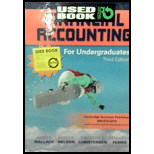
a.
Calculate the company’s cost of goods sold and the ending inventory for the month of April using weighted-average inventory costing method - Perpetual inventory system.
a.
Explanation of Solution
Perpetual Inventory System refers to the inventory system that maintains the detailed records of every inventory transactions related to purchases and sales on a continuous basis. It shows the exact on-hand-inventory at any point of time.
Weighted-average cost method: In moving-average Cost Method, the cost of inventory is priced at the average rate of the goods available for sale. Following is the mathematical representation:
Compute the cost of goods sold and the ending inventory cost for the month of April using perpetual weighted average cost method.
| Date | Purchased | Sold | Inventory Balance | |||||||
| Quantity | Unit Cost ($) | Total Cost ($) | Quantity | Unit Cost ($) | Total Cost ($) | Quantity | Unit Cost ($) | Total Cost ($) | ||
| April | 1 | 120 | 330.00 | 39,600 | ||||||
| 9 | 40 | 345 | 13,800 | 160 | 333.75 | 53,400 | ||||
| 14 | 80 | 333.75 | 26,700 | 80 | 333.75 | 26,700 | ||||
| 23 | 20 | 350 | 7,000 | 100 | 337 | 33,700 | ||||
| 29 | 40 | 337 | $13,480 | 60 | 337 | $20,220 | ||||
Table (1)
Working Notes:
Compute the weighted average cost of inventory after April 9 purchase:

Compute the weighted average cost of inventory after April 23 purchase:

Therefore, the value of cost of goods sold is $13,480 and ending inventory is $20,220.
b.
Calculate the company’s cost of goods sold and the ending inventory for the month of April using FIFO costing method - Perpetual inventory system.
b.
Explanation of Solution
First-in-First-Out: In First-in-First-Out method, the costs of the initially purchased items are considered as cost of goods sold, for the items which are sold first. The value of the ending inventory consists of the recent purchased items.
Compute the cost of goods sold and the ending inventory cost for the month of April using perpetual FIFO method.
| Date | Purchased | Sold | Inventory Balance | |||||||
| Quantity | Unit Cost ($) | Total Cost ($) | Quantity | Unit Cost ($) | Total Cost ($) | Quantity | Unit Cost ($) | Total Cost ($) | ||
| April | 1 | 120 | 330 | 39,600 | ||||||
| 9 | 40 | 345 | 13,800 | 120 | 330 | 39,600 | ||||
| 40 | 345 | 13,800 | ||||||||
| 160 | 53,400 | |||||||||
| 14 | 80 | 330 | 26,400 | 40 | 330 | 13,200 | ||||
| 40 | 345 | 13,800 | ||||||||
| 80 | 27,000 | |||||||||
| 23 | 20 | 350 | 7,000 | 40 | 330 | 13,200 | ||||
| 40 | 345 | 13,800 | ||||||||
| 20 | 350 | 7,000 | ||||||||
| 100 | 34,000 | |||||||||
| 29 | 40 | 330 | 13,200 | 40 | 345 | 13,800 | ||||
| 20 | 350 | 7,000 | ||||||||
| $39,600 | 60 | $20,800 | ||||||||
Table (2)
Therefore, the value of cost of goods sold is $39,000 and ending inventory is $20,800.
c.
Calculate the company’s cost of goods sold and the ending inventory for the month of April using LIFO costing method - Perpetual inventory system.
c.
Explanation of Solution
Last-in-Last-Out: In Last-in-First-Out method, the costs of last purchased items are considered as the cost of goods sold, for the items which are sold first. The value of the closing stock consists of the initial purchased items.
Compute the cost of goods sold and the ending inventory cost for the month of April using perpetual LIFO.
| Date | Purchased | Sold | Inventory Balance | |||||||
| Quantity | Unit Cost ($) | Total Cost ($) | Quantity | Unit Cost ($) | Total Cost ($) | Quantity | Unit Cost ($) | Total Cost ($) | ||
| April | 1 | 120 | 330 | 39,600 | ||||||
| 9 | 40 | 345 | 13,800 | 120 | 330 | 39,600 | ||||
| 40 | 345 | 13,800 | ||||||||
| 160 | 53,400 | |||||||||
| 14 | 40 | 345 | 23,800 | |||||||
| 40 | 330 | 13,200 | 80 | 330 | 26,400 | |||||
| 37,000 | 80 | 26,400 | ||||||||
| 23 | 20 | 350 | 7,000 | 80 | 330 | 26,400 | ||||
| 20 | 350 | 7,000 | ||||||||
| 100 | 33,400 | |||||||||
| 29 | 20 | 350 | 7,000 | |||||||
| 20 | 330 | 6,600 | 60 | 330 | 19,800 | |||||
| $13,600 | 60 | $19,800 | ||||||||
Table (3)
Therefore, the value of cost of goods sold is $13,600 and ending inventory is $19,800.
Want to see more full solutions like this?
Chapter 6 Solutions
FINANCIAL ACCT.F/UNDERGRADS-W/ACCESS

 AccountingAccountingISBN:9781337272094Author:WARREN, Carl S., Reeve, James M., Duchac, Jonathan E.Publisher:Cengage Learning,
AccountingAccountingISBN:9781337272094Author:WARREN, Carl S., Reeve, James M., Duchac, Jonathan E.Publisher:Cengage Learning, Accounting Information SystemsAccountingISBN:9781337619202Author:Hall, James A.Publisher:Cengage Learning,
Accounting Information SystemsAccountingISBN:9781337619202Author:Hall, James A.Publisher:Cengage Learning, Horngren's Cost Accounting: A Managerial Emphasis...AccountingISBN:9780134475585Author:Srikant M. Datar, Madhav V. RajanPublisher:PEARSON
Horngren's Cost Accounting: A Managerial Emphasis...AccountingISBN:9780134475585Author:Srikant M. Datar, Madhav V. RajanPublisher:PEARSON Intermediate AccountingAccountingISBN:9781259722660Author:J. David Spiceland, Mark W. Nelson, Wayne M ThomasPublisher:McGraw-Hill Education
Intermediate AccountingAccountingISBN:9781259722660Author:J. David Spiceland, Mark W. Nelson, Wayne M ThomasPublisher:McGraw-Hill Education Financial and Managerial AccountingAccountingISBN:9781259726705Author:John J Wild, Ken W. Shaw, Barbara Chiappetta Fundamental Accounting PrinciplesPublisher:McGraw-Hill Education
Financial and Managerial AccountingAccountingISBN:9781259726705Author:John J Wild, Ken W. Shaw, Barbara Chiappetta Fundamental Accounting PrinciplesPublisher:McGraw-Hill Education





